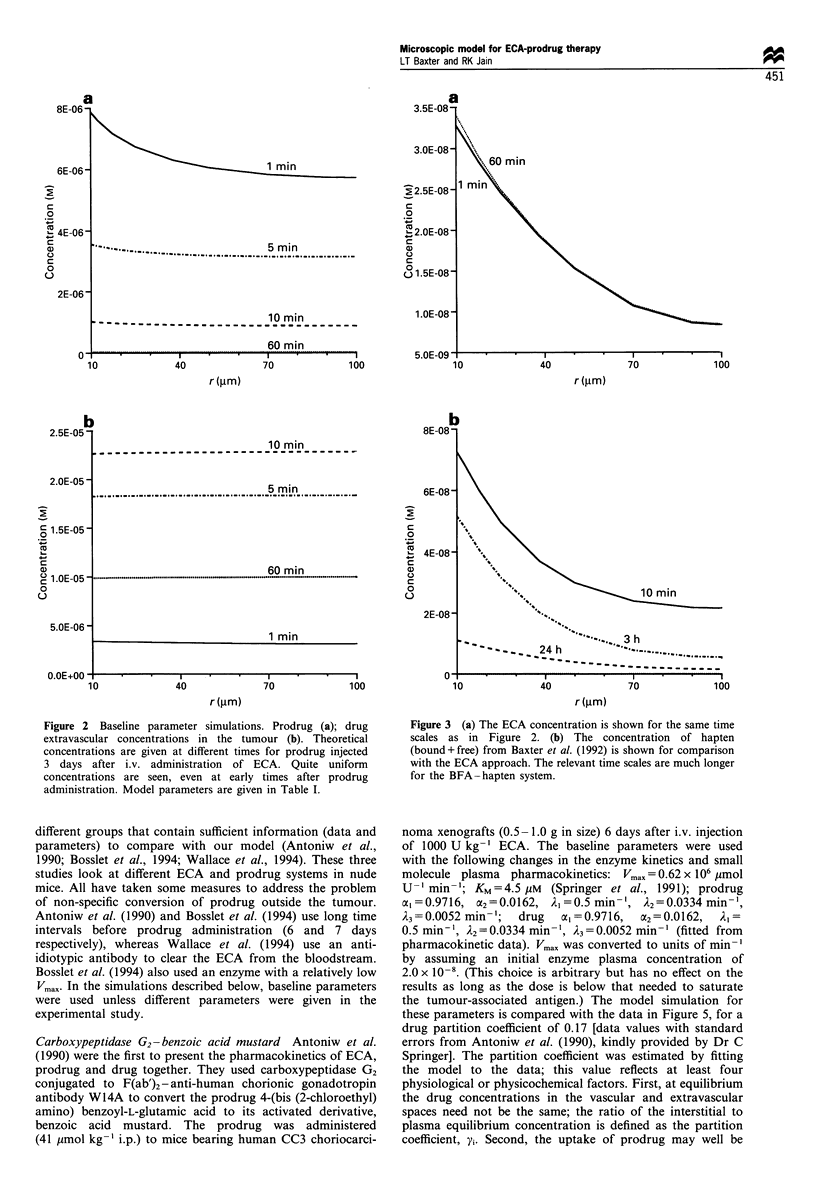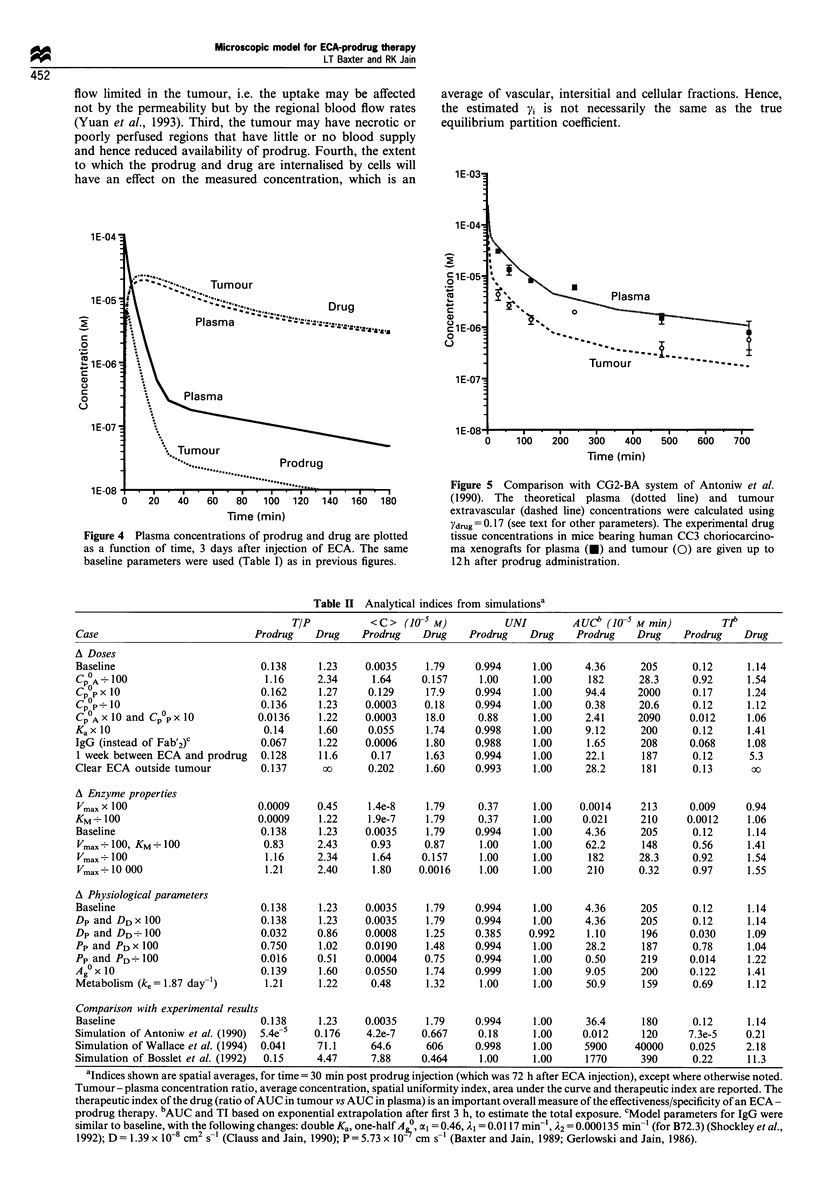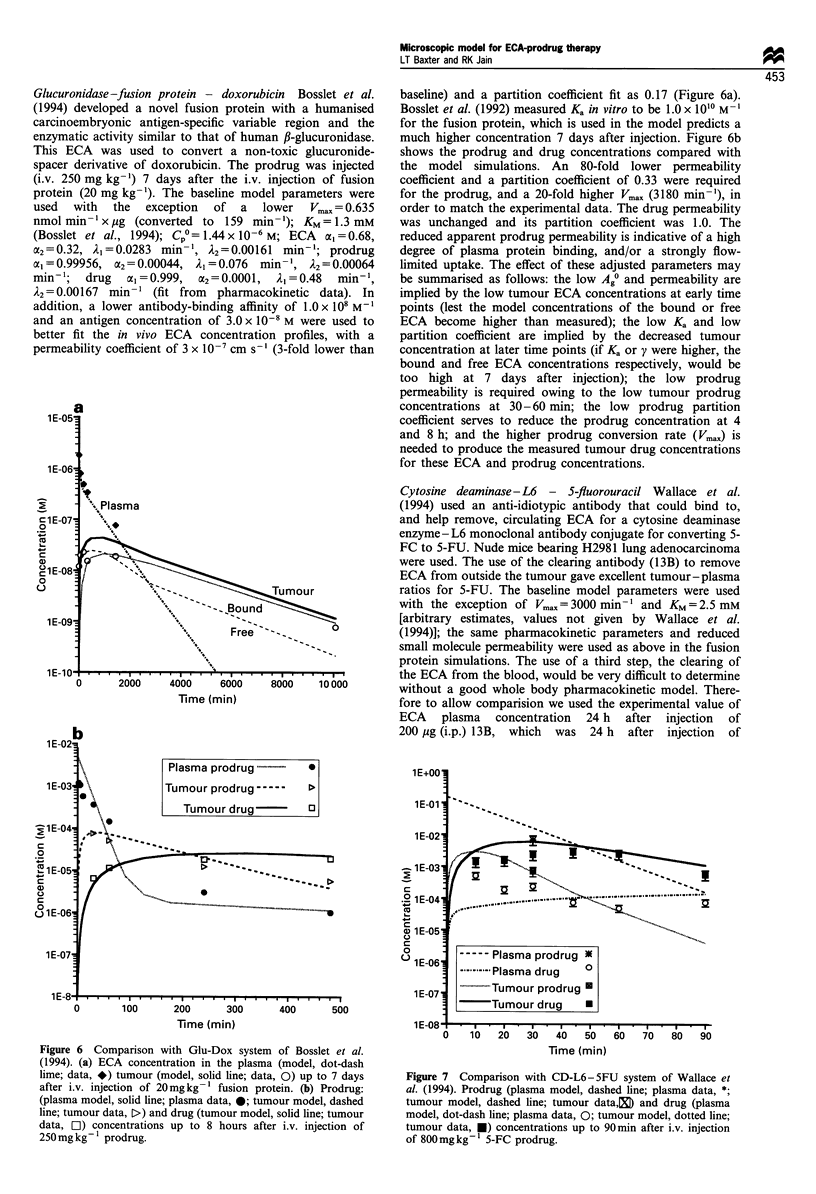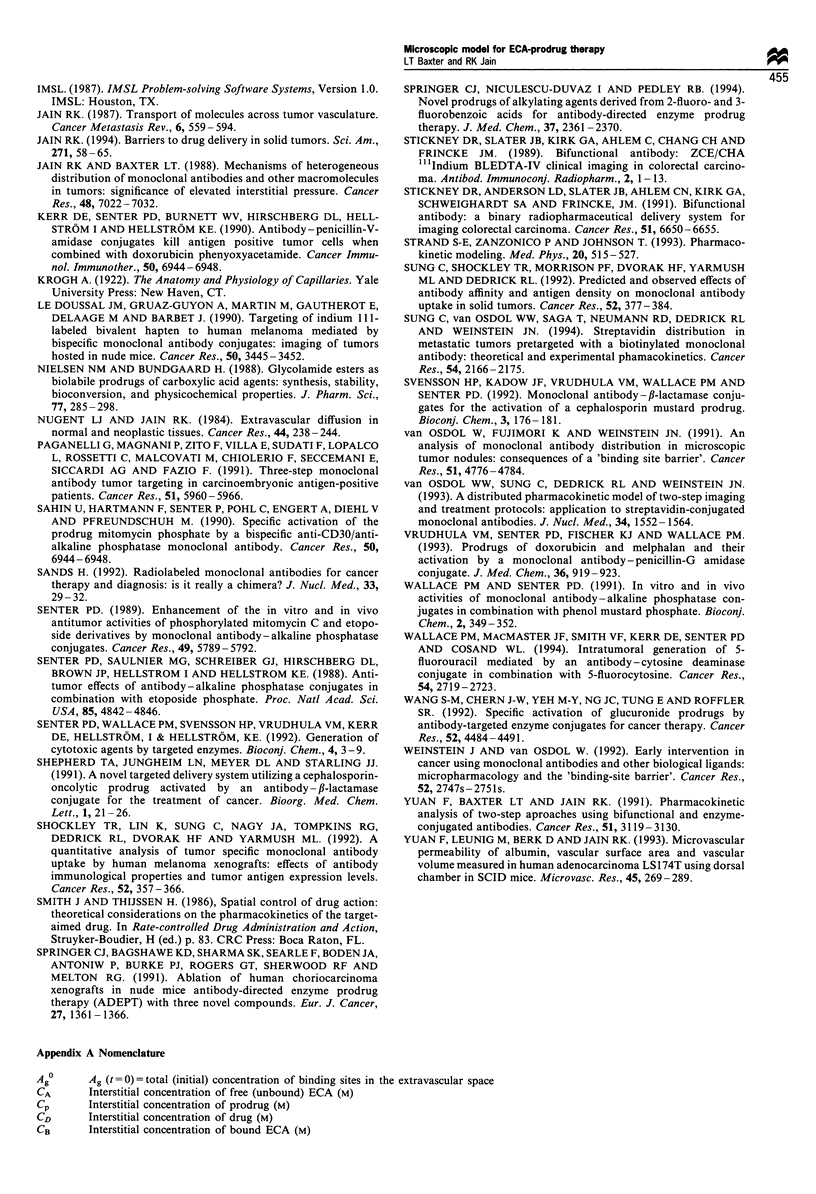Abstract
A mathematical model was developed to improve understanding of the biodistribution and microscopic profiles of drugs and prodrugs in a system using enzyme-conjugated antibodies as part of a two-step method for cancer treatment. The use of monoclonal antibodies alone may lead to heterogeneous uptake within the tumour tissue; the use of a second, low molecular weight agent may provide greater penetration into tumour tissue. This mathematical model was used to describe concentration profiles surrounding individual blood vessels within a tumour. From these profiles the area under the curve and specificity ratios were determined. By integrating these results spatially, average tissue concentrations were determined and compared with experimental results from three different systems in the literature; two using murine antibodies and one using humanised fusion proteins. The maximum enzyme conversion rate (Vmax) and the residual antibody concentration in the plasma and normal tissue were seen to be key determinants of drug concentration and drug-prodrug ratios in the tumour and other organs. Thus, longer time delays between the two injections, clearing the antibody from the blood stream and the use of 'weaker' enzymes (lower Vmax) will be important factors in improving this prodrug approach. Of these, the model found the effective clearance of the antibody outside of the tumour to be the most effective. The use of enzyme-conjugated antibodies may offer the following advantages over the bifunctional antibody-hapten system: (i) more uniform distribution of the active agent; (ii) higher concentrations possible for the active agent; and (iii) greater specificity (therapeutic index).
Full text
PDF









Selected References
These references are in PubMed. This may not be the complete list of references from this article.
- Antoniw P., Springer C. J., Bagshawe K. D., Searle F., Melton R. G., Rogers G. T., Burke P. J., Sherwood R. F. Disposition of the prodrug 4-(bis (2-chloroethyl) amino) benzoyl-L-glutamic acid and its active parent drug in mice. Br J Cancer. 1990 Dec;62(6):909–914. doi: 10.1038/bjc.1990.407. [DOI] [PMC free article] [PubMed] [Google Scholar]
- Bagshawe K. D. Antibody directed enzymes revive anti-cancer prodrugs concept. Br J Cancer. 1987 Nov;56(5):531–532. doi: 10.1038/bjc.1987.237. [DOI] [PMC free article] [PubMed] [Google Scholar]
- Bagshawe K. D., Springer C. J., Searle F., Antoniw P., Sharma S. K., Melton R. G., Sherwood R. F. A cytotoxic agent can be generated selectively at cancer sites. Br J Cancer. 1988 Dec;58(6):700–703. doi: 10.1038/bjc.1988.293. [DOI] [PMC free article] [PubMed] [Google Scholar]
- Baxter L. T., Jain R. K. Transport of fluid and macromolecules in tumors. I. Role of interstitial pressure and convection. Microvasc Res. 1989 Jan;37(1):77–104. doi: 10.1016/0026-2862(89)90074-5. [DOI] [PubMed] [Google Scholar]
- Baxter L. T., Jain R. K. Transport of fluid and macromolecules in tumors. II. Role of heterogeneous perfusion and lymphatics. Microvasc Res. 1990 Sep;40(2):246–263. doi: 10.1016/0026-2862(90)90023-k. [DOI] [PubMed] [Google Scholar]
- Baxter L. T., Jain R. K. Transport of fluid and macromolecules in tumors. III. Role of binding and metabolism. Microvasc Res. 1991 Jan;41(1):5–23. doi: 10.1016/0026-2862(91)90003-t. [DOI] [PubMed] [Google Scholar]
- Baxter L. T., Jain R. K. Transport of fluid and macromolecules in tumors. IV. A microscopic model of the perivascular distribution. Microvasc Res. 1991 Mar;41(2):252–272. doi: 10.1016/0026-2862(91)90026-8. [DOI] [PubMed] [Google Scholar]
- Baxter L. T., Yuan F., Jain R. K. Pharmacokinetic analysis of the perivascular distribution of bifunctional antibodies and haptens: comparison with experimental data. Cancer Res. 1992 Oct 15;52(20):5838–5844. [PubMed] [Google Scholar]
- Baxter L. T., Zhu H., Mackensen D. G., Butler W. F., Jain R. K. Biodistribution of monoclonal antibodies: scale-up from mouse to human using a physiologically based pharmacokinetic model. Cancer Res. 1995 Oct 15;55(20):4611–4622. [PubMed] [Google Scholar]
- Baxter L. T., Zhu H., Mackensen D. G., Jain R. K. Physiologically based pharmacokinetic model for specific and nonspecific monoclonal antibodies and fragments in normal tissues and human tumor xenografts in nude mice. Cancer Res. 1994 Mar 15;54(6):1517–1528. [PubMed] [Google Scholar]
- Bignami G. S., Senter P. D., Grothaus P. G., Fischer K. J., Humphreys T., Wallace P. M. N-(4'-hydroxyphenylacetyl)palytoxin: a palytoxin prodrug that can be activated by a monoclonal antibody-penicillin G amidase conjugate. Cancer Res. 1992 Oct 15;52(20):5759–5764. [PubMed] [Google Scholar]
- Bosslet K., Czech J., Hoffmann D. Tumor-selective prodrug activation by fusion protein-mediated catalysis. Cancer Res. 1994 Apr 15;54(8):2151–2159. [PubMed] [Google Scholar]
- Bosslet K., Czech J., Lorenz P., Sedlacek H. H., Schuermann M., Seemann G. Molecular and functional characterisation of a fusion protein suited for tumour specific prodrug activation. Br J Cancer. 1992 Feb;65(2):234–238. doi: 10.1038/bjc.1992.47. [DOI] [PMC free article] [PubMed] [Google Scholar]
- Bush R. S., Jenkin R. D., Allt W. E., Beale F. A., Bean H., Dembo A. J., Pringle J. F. Definitive evidence for hypoxic cells influencing cure in cancer therapy. Br J Cancer Suppl. 1978 Jun;3:302–306. [PMC free article] [PubMed] [Google Scholar]
- Clauss M. A., Jain R. K. Interstitial transport of rabbit and sheep antibodies in normal and neoplastic tissues. Cancer Res. 1990 Jun 15;50(12):3487–3492. [PubMed] [Google Scholar]
- Collard J., Matthew A. M., Double J. A., Bibby M. C. EO9: relationship between DT-diaphorase levels and response in vitro and in vivo. Br J Cancer. 1995 Jun;71(6):1199–1203. doi: 10.1038/bjc.1995.233. [DOI] [PMC free article] [PubMed] [Google Scholar]
- Eccles S. A., Court W. J., Box G. A., Dean C. J., Melton R. G., Springer C. J. Regression of established breast carcinoma xenografts with antibody-directed enzyme prodrug therapy against c-erbB2 p185. Cancer Res. 1994 Oct 1;54(19):5171–5177. [PubMed] [Google Scholar]
- Fujimori K., Covell D. G., Fletcher J. E., Weinstein J. N. A modeling analysis of monoclonal antibody percolation through tumors: a binding-site barrier. J Nucl Med. 1990 Jul;31(7):1191–1198. [PubMed] [Google Scholar]
- Fujimori K., Covell D. G., Fletcher J. E., Weinstein J. N. Modeling analysis of the global and microscopic distribution of immunoglobulin G, F(ab')2, and Fab in tumors. Cancer Res. 1989 Oct 15;49(20):5656–5663. [PubMed] [Google Scholar]
- Gerlowski L. E., Jain R. K. Microvascular permeability of normal and neoplastic tissues. Microvasc Res. 1986 May;31(3):288–305. doi: 10.1016/0026-2862(86)90018-x. [DOI] [PubMed] [Google Scholar]
- Haisma H. J., Boven E., van Muijen M., de Jong J., van der Vijgh W. J., Pinedo H. M. A monoclonal antibody-beta-glucuronidase conjugate as activator of the prodrug epirubicin-glucuronide for specific treatment of cancer. Br J Cancer. 1992 Sep;66(3):474–478. doi: 10.1038/bjc.1992.298. [DOI] [PMC free article] [PubMed] [Google Scholar]
- Hellström K. E., Senter P. D. Activation of prodrugs by targeted enzymes. Eur J Cancer. 1991;27(11):1342–1343. doi: 10.1016/0277-5379(91)90003-v. [DOI] [PubMed] [Google Scholar]
- Hnatowich D. J., Virzi F., Rusckowski M. Investigations of avidin and biotin for imaging applications. J Nucl Med. 1987 Aug;28(8):1294–1302. [PubMed] [Google Scholar]
- Houston A. S., Sampson W. F., Macleod M. A. A compartmental model for the distribution of 113mIn-DTPA and 99mTc-(Sn)DTPA in man following intravenous injection. Int J Nucl Med Biol. 1979;6(2):85–95. doi: 10.1016/0047-0740(79)90002-0. [DOI] [PubMed] [Google Scholar]
- Jain R. K. Barriers to drug delivery in solid tumors. Sci Am. 1994 Jul;271(1):58–65. doi: 10.1038/scientificamerican0794-58. [DOI] [PubMed] [Google Scholar]
- Jain R. K., Baxter L. T. Mechanisms of heterogeneous distribution of monoclonal antibodies and other macromolecules in tumors: significance of elevated interstitial pressure. Cancer Res. 1988 Dec 15;48(24 Pt 1):7022–7032. [PubMed] [Google Scholar]
- Jain R. K. Transport of molecules across tumor vasculature. Cancer Metastasis Rev. 1987;6(4):559–593. doi: 10.1007/BF00047468. [DOI] [PubMed] [Google Scholar]
- Krupski G., Kiefer F., Wiebel F. J. Variability in the expression of xenobiotic-metabolizing enzymes during the growth cycle of rat hepatoma cells. Xenobiotica. 1985 Aug-Sep;15(8-9):781–787. doi: 10.3109/00498258509047441. [DOI] [PubMed] [Google Scholar]
- Le Doussal J. M., Gruaz-Guyon A., Martin M., Gautherot E., Delaage M., Barbet J. Targeting of indium 111-labeled bivalent hapten to human melanoma mediated by bispecific monoclonal antibody conjugates: imaging of tumors hosted in nude mice. Cancer Res. 1990 Jun 1;50(11):3445–3452. [PubMed] [Google Scholar]
- McAleer J. J., McKeown S. R., MacManus M. P., Lappin T. R., Bridges J. M. Hypobaric hypoxia: a method for testing bioreductive drugs in vivo. Int J Radiat Oncol Biol Phys. 1992;23(3):551–555. doi: 10.1016/0360-3016(92)90010-f. [DOI] [PubMed] [Google Scholar]
- McKelvey-Martin V. J., Green M. H., Schmezer P., Pool-Zobel B. L., De Méo M. P., Collins A. The single cell gel electrophoresis assay (comet assay): a European review. Mutat Res. 1993 Jul;288(1):47–63. doi: 10.1016/0027-5107(93)90207-v. [DOI] [PubMed] [Google Scholar]
- McKeown S. R., Hejmadi M. V., McIntyre I. A., McAleer J. J., Patterson L. H. AQ4N: an alkylaminoanthraquinone N-oxide showing bioreductive potential and positive interaction with radiation in vivo. Br J Cancer. 1995 Jul;72(1):76–81. doi: 10.1038/bjc.1995.280. [DOI] [PMC free article] [PubMed] [Google Scholar]
- Moore J. V. The dynamics of tumor cords in an irradiated mouse mammary carcinoma with a large hypoxic cell component. Jpn J Cancer Res. 1988 Feb;79(2):236–243. doi: 10.1111/j.1349-7006.1988.tb01582.x. [DOI] [PMC free article] [PubMed] [Google Scholar]
- Nielsen N. M., Bundgaard H. Glycolamide esters as biolabile prodrugs of carboxylic acid agents: synthesis, stability, bioconversion, and physicochemical properties. J Pharm Sci. 1988 Apr;77(4):285–298. doi: 10.1002/jps.2600770402. [DOI] [PubMed] [Google Scholar]
- Nugent L. J., Jain R. K. Extravascular diffusion in normal and neoplastic tissues. Cancer Res. 1984 Jan;44(1):238–244. [PubMed] [Google Scholar]
- Okunieff P., Hoeckel M., Dunphy E. P., Schlenger K., Knoop C., Vaupel P. Oxygen tension distributions are sufficient to explain the local response of human breast tumors treated with radiation alone. Int J Radiat Oncol Biol Phys. 1993 Jul 15;26(4):631–636. doi: 10.1016/0360-3016(93)90280-9. [DOI] [PubMed] [Google Scholar]
- Olive P. L., Banáth J. P., Durand R. E. Heterogeneity in radiation-induced DNA damage and repair in tumor and normal cells measured using the "comet" assay. Radiat Res. 1990 Apr;122(1):86–94. [PubMed] [Google Scholar]
- Olive P. L., Banáth J. P. Growth fraction measured using the comet assay. Cell Prolif. 1992 Sep;25(5):447–457. doi: 10.1111/j.1365-2184.1992.tb01453.x. [DOI] [PubMed] [Google Scholar]
- Olive P. L. Radiation-induced reoxygenation in the SCCVII murine tumour: evidence for a decrease in oxygen consumption and an increase in tumour perfusion. Radiother Oncol. 1994 Jul;32(1):37–46. doi: 10.1016/0167-8140(94)90447-2. [DOI] [PubMed] [Google Scholar]
- Paganelli G., Magnani P., Zito F., Villa E., Sudati F., Lopalco L., Rossetti C., Malcovati M., Chiolerio F., Seccamani E. Three-step monoclonal antibody tumor targeting in carcinoembryonic antigen-positive patients. Cancer Res. 1991 Nov 1;51(21):5960–5966. [PubMed] [Google Scholar]
- Patterson L. H., Craven M. R., Fisher G. R., Teesdale-Spittle P. Aliphatic amine N-oxides of DNA binding agents as bioreductive drugs. Oncol Res. 1994;6(10-11):533–538. [PubMed] [Google Scholar]
- Patterson L. H. Rationale for the use of aliphatic N-oxides of cytotoxic anthraquinones as prodrug DNA binding agents: a new class of bioreductive agent. Cancer Metastasis Rev. 1993 Jun;12(2):119–134. doi: 10.1007/BF00689805. [DOI] [PubMed] [Google Scholar]
- Sahin U., Hartmann F., Senter P., Pohl C., Engert A., Diehl V., Pfreundschuh M. Specific activation of the prodrug mitomycin phosphate by a bispecific anti-CD30/anti-alkaline phosphatase monoclonal antibody. Cancer Res. 1990 Nov 1;50(21):6944–6948. [PubMed] [Google Scholar]
- Sands H. Radiolabeled monoclonal antibodies for cancer therapy and diagnosis: is it really a chimera? J Nucl Med. 1992 Jan;33(1):29–32. [PubMed] [Google Scholar]
- Senter P. D., Saulnier M. G., Schreiber G. J., Hirschberg D. L., Brown J. P., Hellström I., Hellström K. E. Anti-tumor effects of antibody-alkaline phosphatase conjugates in combination with etoposide phosphate. Proc Natl Acad Sci U S A. 1988 Jul;85(13):4842–4846. doi: 10.1073/pnas.85.13.4842. [DOI] [PMC free article] [PubMed] [Google Scholar]
- Senter P. D., Schreiber G. J., Hirschberg D. L., Ashe S. A., Hellström K. E., Hellström I. Enhancement of the in vitro and in vivo antitumor activities of phosphorylated mitomycin C and etoposide derivatives by monoclonal antibody-alkaline phosphatase conjugates. Cancer Res. 1989 Nov 1;49(21):5789–5792. [PubMed] [Google Scholar]
- Shockley T. R., Lin K., Sung C., Nagy J. A., Tompkins R. G., Dedrick R. L., Dvorak H. F., Yarmush M. L. A quantitative analysis of tumor specific monoclonal antibody uptake by human melanoma xenografts: effects of antibody immunological properties and tumor antigen expression levels. Cancer Res. 1992 Jan 15;52(2):357–366. [PubMed] [Google Scholar]
- Singh N. P., McCoy M. T., Tice R. R., Schneider E. L. A simple technique for quantitation of low levels of DNA damage in individual cells. Exp Cell Res. 1988 Mar;175(1):184–191. doi: 10.1016/0014-4827(88)90265-0. [DOI] [PubMed] [Google Scholar]
- Springer C. J., Bagshawe K. D., Sharma S. K., Searle F., Boden J. A., Antoniw P., Burke P. J., Rogers G. T., Sherwood R. F., Melton R. G. Ablation of human choriocarcinoma xenografts in nude mice by antibody-directed enzyme prodrug therapy (ADEPT) with three novel compounds. Eur J Cancer. 1991;27(11):1361–1366. doi: 10.1016/0277-5379(91)90010-b. [DOI] [PubMed] [Google Scholar]
- Springer C. J., Niculescu-Duvaz I., Pedley R. B. Novel prodrugs of alkylating agents derived from 2-fluoro- and 3-fluorobenzoic acids for antibody-directed enzyme prodrug therapy. J Med Chem. 1994 Jul 22;37(15):2361–2370. doi: 10.1021/jm00041a015. [DOI] [PubMed] [Google Scholar]
- Stickney D. R., Anderson L. D., Slater J. B., Ahlem C. N., Kirk G. A., Schweighardt S. A., Frincke J. M. Bifunctional antibody: a binary radiopharmaceutical delivery system for imaging colorectal carcinoma. Cancer Res. 1991 Dec 15;51(24):6650–6655. [PubMed] [Google Scholar]
- Strand S. E., Zanzonico P., Johnson T. K. Pharmacokinetic modeling. Med Phys. 1993 Mar-Apr;20(2 Pt 2):515–527. doi: 10.1118/1.597047. [DOI] [PubMed] [Google Scholar]
- Sung C., Shockley T. R., Morrison P. F., Dvorak H. F., Yarmush M. L., Dedrick R. L. Predicted and observed effects of antibody affinity and antigen density on monoclonal antibody uptake in solid tumors. Cancer Res. 1992 Jan 15;52(2):377–384. [PubMed] [Google Scholar]
- Sung C., van Osdol W. W., Saga T., Neumann R. D., Dedrick R. L., Weinstein J. N. Streptavidin distribution in metastatic tumors pretargeted with a biotinylated monoclonal antibody: theoretical and experimental pharmacokinetics. Cancer Res. 1994 Apr 15;54(8):2166–2175. [PubMed] [Google Scholar]
- Svensson H. P., Kadow J. F., Vrudhula V. M., Wallace P. M., Senter P. D. Monoclonal antibody-beta-lactamase conjugates for the activation of a cephalosporin mustard prodrug. Bioconjug Chem. 1992 Mar-Apr;3(2):176–181. doi: 10.1021/bc00014a013. [DOI] [PubMed] [Google Scholar]
- Vrudhula V. M., Senter P. D., Fischer K. J., Wallace P. M. Prodrugs of doxorubicin and melphalan and their activation by a monoclonal antibody-penicillin-G amidase conjugate. J Med Chem. 1993 Apr 2;36(7):919–923. doi: 10.1021/jm00059a018. [DOI] [PubMed] [Google Scholar]
- Wallace P. M., MacMaster J. F., Smith V. F., Kerr D. E., Senter P. D., Cosand W. L. Intratumoral generation of 5-fluorouracil mediated by an antibody-cytosine deaminase conjugate in combination with 5-fluorocytosine. Cancer Res. 1994 May 15;54(10):2719–2723. [PubMed] [Google Scholar]
- Wallace P. M., Senter P. D. In vitro and in vivo activities of monoclonal antibody-alkaline phosphatase conjugates in combination with phenol mustard phosphate. Bioconjug Chem. 1991 Sep-Oct;2(5):349–352. doi: 10.1021/bc00011a010. [DOI] [PubMed] [Google Scholar]
- Wang S. M., Chern J. W., Yeh M. Y., Ng J. C., Tung E., Roffler S. R. Specific activation of glucuronide prodrugs by antibody-targeted enzyme conjugates for cancer therapy. Cancer Res. 1992 Aug 15;52(16):4484–4491. [PubMed] [Google Scholar]
- Weinstein J. N., van Osdol W. Early intervention in cancer using monoclonal antibodies and other biological ligands: micropharmacology and the "binding site barrier". Cancer Res. 1992 May 1;52(9 Suppl):2747s–2751s. [PubMed] [Google Scholar]
- Whitaker S. J., Powell S. N., McMillan T. J. Molecular assays of radiation-induced DNA damage. Eur J Cancer. 1991;27(7):922–928. doi: 10.1016/0277-5379(91)90148-7. [DOI] [PubMed] [Google Scholar]
- Workman P., Stratford I. J. The experimental development of bioreductive drugs and their role in cancer therapy. Cancer Metastasis Rev. 1993 Jun;12(2):73–82. doi: 10.1007/BF00689802. [DOI] [PubMed] [Google Scholar]
- Yuan F., Baxter L. T., Jain R. K. Pharmacokinetic analysis of two-step approaches using bifunctional and enzyme-conjugated antibodies. Cancer Res. 1991 Jun 15;51(12):3119–3130. [PubMed] [Google Scholar]
- Yuan F., Leunig M., Berk D. A., Jain R. K. Microvascular permeability of albumin, vascular surface area, and vascular volume measured in human adenocarcinoma LS174T using dorsal chamber in SCID mice. Microvasc Res. 1993 May;45(3):269–289. doi: 10.1006/mvre.1993.1024. [DOI] [PubMed] [Google Scholar]
- van Osdol W. W., Sung C., Dedrick R. L., Weinstein J. N. A distributed pharmacokinetic model of two-step imaging and treatment protocols: application to streptavidin-conjugated monoclonal antibodies and radiolabeled biotin. J Nucl Med. 1993 Sep;34(9):1552–1564. [PubMed] [Google Scholar]
- van Osdol W., Fujimori K., Weinstein J. N. An analysis of monoclonal antibody distribution in microscopic tumor nodules: consequences of a "binding site barrier". Cancer Res. 1991 Sep 15;51(18):4776–4784. [PubMed] [Google Scholar]


